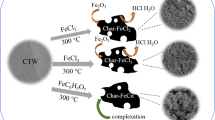Abstract
Bio-char is a carbon-enriched and porous material produced from a variety of biomass. When bio-char is produced from biomass, approximately 50 % of the carbon that the plants absorbed as CO2 from the atmosphere is “fixed” in the charcoal. Bio-char is similar in its appearance to charcoal and activated carbon.
In this study tomato factory waste has been used for the production of the bio-char. Biomass with a mean particle size was carbonized at 623 K in a furnace. Biomass and bio-char were characterized by using elemental analyses, Fourier Transform Infrared Spectroscopy (FTIR), and scanning electron microscope (SEM) analysis.
The adsorption capacity of the bio-char produced with carbonization of tomato factory waste has been evaluated with the Co(II) ion removal to investigate the effects of pH, amount of adsorbent, initial concentration of the aqueous solution, adsorption time, and solution temperature. To describe the equilibrium isotherms Langmuir and Freundlich models were applied. Pseudo-first order and pseudo-second order kinetic models were used to find out the kinetic parameters and mechanism of adsorption process with increasing adsorbent dosage from 1 to 10 g/l in the batch mode. The final heavy metal concentrations have been reduced from 59 to 8 ppm and removal efficiencies have been increased from 60 to 82 % respectively.
Experimental results showed that, tomato factory waste char seems to be an effective and alternative adsorbent precursor for the removal of heavy metal ions from aqueous solutions due to its high adsorption capacity, low cost, and availability.
Access this chapter
Tax calculation will be finalised at checkout
Purchases are for personal use only
Similar content being viewed by others
References
Lazarevica S, Jankovic-Castvana I, Potkonjak B, Janackovic D, Petrovica R (2012) Removal of Co2+ ions from aqueous solutions using iron-functionalized sepiolite. Chem Eng Process 55:40–47
Liu Y, Chen M, Hao Y (2013) Study on the adsorption of Cu(II) by EDTA functionalized Fe3O4 magnetic nano-particles. Chem Eng J 218:46–54
Fagundes-Klen MR, Ferri P, Martins TD, Tavares CRG, Silva EA (2007) Equilibrium study of the binary mixture of cadmium-zinc ions biosorption by the Sargassum filipendula species using adsorption isotherms models and neural network. Biochem Eng J 34:136–146
Çay S, Uyanık A, Özaşık A (2004) Single and binary component adsorption of copper (II) and cadmium (II) from aqueous solutions using tea-industry waste. Sep Purif Technol 38:273–280
Lakshmipathy R, Sarada NC (2013) Application of watermelon rind as sorbent for removal of nickel and cobalt from aqueous solution. Int J Miner Process 122:63–65
Vimala R, Das N (2009) Biosorption of cadmium (II) and lead (II) from aqueous solutions using mushrooms: a comparative study. J Hazard Mater 168:376–382
Özbay N, Yargıç AŞ, Yarbay-Şahin RZ, Önal E (2013) Full factorial experimental design analysis of reactive dye removal by carbon adsorption. J Chem 2013:13 pp. doi:10.1155/2013/234904, Article ID 234904
Gupta N, Kushwaha AK, Chattopadhyaya MC (2012) Adsorptive removal of Pb2+, Co2+ and Ni2+ by hydroxyapatite/chitosan composite from aqueous solution. J Taiwan Inst Chem Eng 43:125–131
Author information
Authors and Affiliations
Corresponding author
Editor information
Editors and Affiliations
Nomenclature
Nomenclature
- b:
-
Langmuir coefficient related to adsorption energy, l/mg
- C1 :
-
Final metal concentration, mg/l
- Ce :
-
Concentration of metal ions in solution at equilibrium, mg/l
- Co :
-
Initial metal concentration, mg/l
- FTIR:
-
Fourier transform infrared spectroscopy
- k1 :
-
Rate constant of the pseudo-first-order, 1/min
- k2 :
-
Rate constant of the pseudo-second-order model, g/(mmol/min)
- M:
-
Mass of the adsorbent, g
- qe :
-
Amount of metal ions at equilibrium in unit mass of adsorbent, mg/g
- qmax :
-
Langmuir coefficient related to adsorption capacity
- qt :
-
Amounts of sorbed Co2+ at time t, mmol/g
- RL :
-
Dimensionless constant separation factor
- SEM:
-
Scanning electron microscope analysis
- t:
-
Contact time, min
- V:
-
Solution volume, l
Rights and permissions
Copyright information
© 2014 Springer International Publishing Switzerland
About this chapter
Cite this chapter
Önal, E., Özbay, N., Yargıç, A.Ş., Şahin, R.Z.Y., Gök, Ö. (2014). Performance Evaluation of the Bio-char Heavy Metal Removal Produced from Tomato Factory Waste. In: Dincer, I., Midilli, A., Kucuk, H. (eds) Progress in Exergy, Energy, and the Environment. Springer, Cham. https://doi.org/10.1007/978-3-319-04681-5_70
Download citation
DOI: https://doi.org/10.1007/978-3-319-04681-5_70
Published:
Publisher Name: Springer, Cham
Print ISBN: 978-3-319-04680-8
Online ISBN: 978-3-319-04681-5
eBook Packages: EnergyEnergy (R0)




